2015 Tesla Model S P85D

WHAT WE LIKE: After 16 months and more than 33,000 miles, our Tesla Model S P85D has made the impression that electric vehicles can serve as practical daily transportation with few compromises as to where, when, or how fast we drive. Some staffers have fully bought in to the idea of quiet, smooth acceleration as the ultimate luxury. “This makes anything with a three-pointed star seem oh so Karl Benz,” testing director Don Sherman said.
Our Model S’s big 85-kWh battery (recently surpassed by a 100-kWh option) has enough capacity to cover 150 miles before the driver even needs to think about plugging in. As Sherman described it: “This Tesla does convert your driving style in a bimodal way. With a full pack, you indulge the stimulating acceleration abilities, changing the lives of the uninitiated who buckle up for a quick spurt. The last half of the range changes one to a hypermiler to milk every last mile before the plug.”
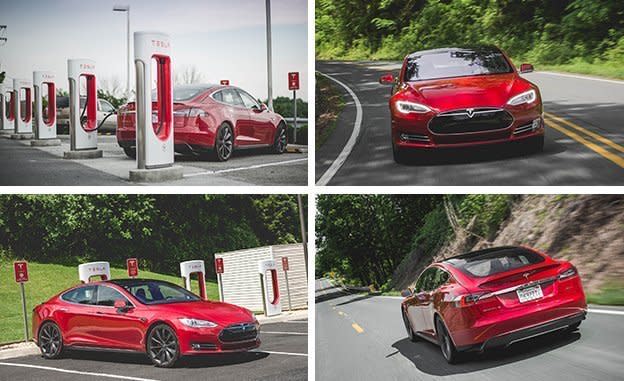
While the EPA rates the P85D at 253 miles of range, we conducted our own formal range test on a mild 75-degree day in June, driving from Ann Arbor to Kalamazoo, Michigan, and back. Our procedure involved setting the battery to its trip mode, adjusting the automatic climate control to 72 degrees with the range-mode setting turned on. We then traveled Interstate 94 with the adaptive cruise control set at 75 mph, negotiating what little traffic there was to maintain that speed as much as possible. The Model S predicted 246 miles of range at the beginning of the test, but we covered 206 miles before rolling into the Ann Arbor Supercharger with the indicator showing only three miles remaining.
That number is the farthest we’ve driven between charges, but a few staffers think the Model S P85D can go even longer distances without reducing the average speed. During his second annual trip to Virginia International Raceway in our Tesla, online editor Alexander Stoklosa drove 201 miles between Superchargers at or near the posted speed limits and still had an indicated 50 miles remaining. Aside from our Kalamazoo range test, that’s the farthest we’ve traveled on a single charge. No one has had the gumption to actually prove that the Tesla can go farther, so we’re accumulating miles a little more slowly toward the 40,000-mile goal than we usually do in similar cars that are gasoline powered.
WHAT WE DON’T LIKE: “If the first time I drove this car was in its current state, I don’t think I would be very impressed,” associate online editor Joseph Capparella noted in the Tesla’s logbook. Capparella pointed to the squeaky brakes, several rattles, worn-looking leather, and a driver’s seat that rocks on its mounts as evidence that our Model S has lost more luster than most of the vehicles that endure our long-term test regimen. “It just doesn’t feel solidly screwed together,” he wrote.
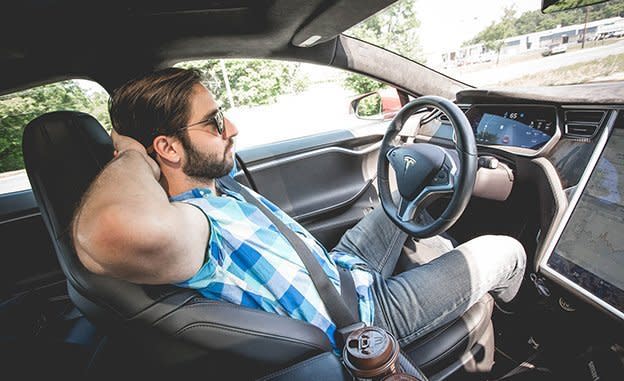
He isn’t alone in that assessment. Some interior trim pieces show excessive amounts of play when pressed lightly, and without the din of a combustion engine to mask rattles and creaks, anything that moves unnecessarily has the potential to be a nuisance in a Tesla. “The driver’s seat is squeaky. So is the driver’s-door window when it’s powered up or down. The brakes, too, are squeaky. This is a squeaky car,” logged Stoklosa.
We continue to be aggravated by the glacial responses of the 17-inch touchscreen that we reported about in our previous update. Our Tesla service center insists that it’s behaving normally and recommends only periodic resets of the system by simultaneously holding down the scroll wheels on the left and right spokes of the steering wheel. That’s the kind of troubleshooting we expect from the corporate IT help desk, not a forward-thinking Silicon Valley startup, especially since resetting the system does nothing to improve the situation.
WHAT WENT WRONG: In addition to the efficiency benefits and the relatively low cost of electricity (a national average of 13 cents per kilowatt-hour), we’ve been promised that electric vehicles will deliver lower operating costs due to reduced maintenance requirements. But at $756, the Model S’s 25,000-mile service was apparently priced according to its $136,720 window sticker. As with the 12,500-mile service, the second maintenance visit involved replacing the wiper blades, the key-fob battery, and the cabin air filter. The pricey bits were the replacement of the air-conditioning desiccant bag and the brake fluid. The latter job was not entirely successful, given the squishy brake pedal we experienced after the brake-bleed exercise. Tesla also replaced some of the seals around the sunroof under warranty to address a small leak over the passenger seat during rainstorms.
The leak continued, though, until we sent the car back to the service center two months later and Tesla technicians cleaned out the drain line, fixing the issue. The real impetus for that visit, though, was a loud, frequent knocking sound emanating from the front suspension. The technicians diagnosed the noise as a worn ball joint, and Tesla replaced the left-front lower control arm under warranty.
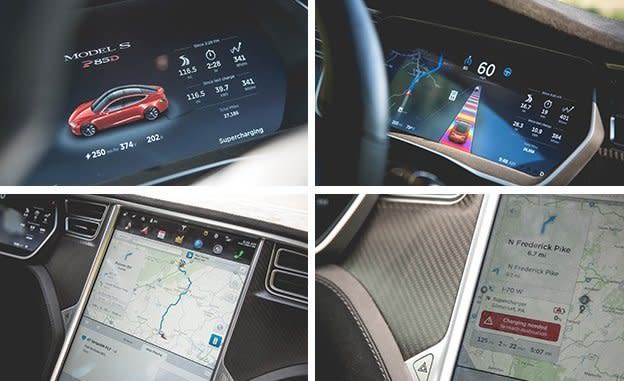
The replacement for the bent driver’s seat that was installed in November 2015 is now loose and rocking, so a second replacement (actually the third, if you count the seat that was installed only long enough for technicians to determine that it, too, was damaged) is now on its way to us. One driver also reported that the rear-facing jump seat became unlatched while it was occupied by a child. This happened during an uphill right-hand turn, but we’ve been unable to reproduce it, and the dealer found nothing wrong during an inspection.
With just over 31,000 miles on the Tesla’s odometer, we spent $725 for two new Michelin Pilot Sport PS2 front tires to replace the original pair, which had worn out. During the swap, we discovered that the right-front wheel was bent. A local wheel-repair specialist determined that the wheel was unfixable, so we ordered a replacement from Tesla and swapped to 19-inch wheels and all-season tires while awaiting its arrival.
In light of all that, it hardly seems worth mentioning the windshield rock chip that was repaired for $30.
WHERE WE WENT: One year after his pioneering long-distance road trip in our Tesla, Stoklosa repeated the drive from Ann Arbor to Virginia International Raceway and back. Armed with the wisdom of his previous trip and more confidence in the Tesla’s range, he eschewed the Model S’s built-in trip-planning algorithm and plotted his own route, minimizing the number of stops and the amount of time needed to charge. His work paid off when he shaved more than one and a half hours from the previous year’s quickest one-way trip. For more detail on that 1500-mile journey, read the full account.
Months in Fleet: 16 months Current Mileage: 33,028 miles
Average Fuel Economy: 68 MPGe Battery Capacity: 85 kWh C/D Observed Range: 206 miles
Service: $756 Normal Wear: $725 Repair: $0
Damage and Destruction: $1497
Specifications >
VEHICLE TYPE: front- and rear-motor, 4-wheel-drive, 7-passenger, 5-door hatchback
PRICE AS TESTED: $136,720 (base price: $105,670)
MOTOR TYPE: front: AC induction, 221 hp, 243 lb-ft; rear: AC induction, 470 hp, 443 lb-ft; combined power rating, 463 hp, 687 lb-ft; 85-kWh lithium-ion battery pack
TRANSMISSION: 1-speed direct drive
DIMENSIONS:
Wheelbase: 116.5 in
Length: 196.0 in
Width: 77.3 in Height: 56.5 in
Passenger volume: 115 cu ft
Cargo volume (C/D est): 3 cu ft
Curb weight: 5010 lb
PERFORMANCE: NEW
Zero to 60 mph: 3.3 sec
Zero to 100 mph: 8.6 sec
Zero to 130 mph: 16.8 sec
Zero to 150 mph: 29.4 sec
Rolling start, 5–60 mph: 4.1 sec
Top gear, 30–50 mph: 1.9 sec
Top gear, 50–70 mph: 2.9 sec
Standing ¼-mile: 11.8 sec @ 114 mph
Top speed (governor limited): 160 mph
Braking, 70–0 mph: 161 ft
Roadholding, 300-ft-dia skidpad: 0.89 g
FUEL ECONOMY:
EPA city/highway driving: 89/98 MPGe
C/D observed: 68 MPGe
C/D observed range: 206 miles
WARRANTY:
4 years/50,000 miles bumper to bumper;
8 years/unlimited miles powertrain;
4 years/50,000 miles roadside assistance
It’s too early to know whether Tesla will amount to an entire chapter or a mere footnote in the annals of automotive history, but the company’s Model S will leave a record here at Car and Driver: We’ve embarked on our first full-length long-term test of a battery-electric car. (We previously conducted a four-month test of a 2011 Nissan Leaf.) Over the coming months, a 2015 Tesla Model S P85D will cover 40,000 miles, logged no more than 250 miles at a time between battery charges. Concerns among the staff that the Tesla’s stay would stretch well beyond that of a gas-swilling vehicle have rapidly evaporated, though. Our Model S racked up 5262 miles during its first two months.
If it seems like we’re late to the Tesla party, know that it wasn’t for a lack of effort on our part. Despite invitations in earlier years, Tesla only provided a Model S for our annual 10Best evaluation this past September—at which time the electric car promptly earned a spot on our list of the greatest cars on sale today. Forty-thousand miles in a Model S will complete the picture of the Tesla experience, offering new insight into ownership and the car’s long-term reliability.
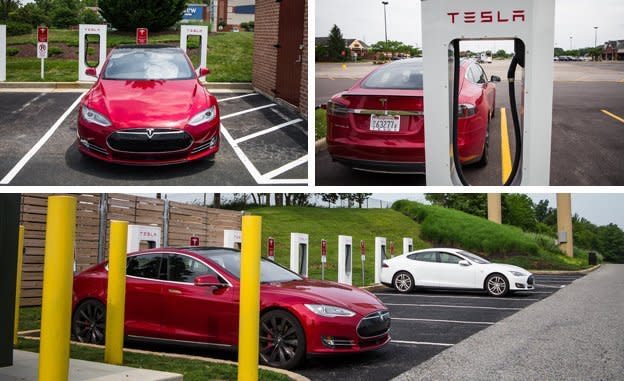
For reasons both practical and hedonistic, our long-term car is the top-performing Model S P85D. Its standard all-wheel drive will help us plow through the winter months, and the large, 85-kWh battery pack eases the range anxiety that comes with trying to accumulate 40,000 miles on the odometer in a timely manner. Of course, we were also wooed by Tesla’s claim that the P85D can hit 60 mph in 3.1 seconds.
The P85D’s steep, $105,670 base price set the tone as we ran down the options list. Accordingly, our Model S is fitted with every available feature, save for the executive rear-seating package. It is outfitted with a leather dashboard, a microsuede headliner, carbon-fiber trim, a small lip spoiler, 21-inch wheels ($4500), and $1500 in red paint. The $4250 Autopilot package adds adaptive cruise control, lane-keeping assist, self-parking, and automatic high beams. “Next-generation” front seats, at a cost of $3500, have earned high praise from our drivers for being better sculpted than the standard seats. Our car is also equipped with a 12-speaker stereo, an air suspension, a panoramic glass roof, a heated steering wheel, heated second-row seats, and rear-facing third-row seats. The optional dual onboard chargers allow us to add range at up to 58 miles per hour when we hook up to a 240-volt, 80-amp circuit. All in, our Tesla Model S P85D carries a sticker price of $136,720 before the $7500 federal tax credit—our most expensive long-termer ever, not to mention the most powerful, with the P85D’s combined 691-hp rating.
We ultimately intend to take full advantage of the dual chargers by installing a dedicated 100-amp circuit in the Car and Driver garage. For now, we primarily charge using our existing 240-volt, 30-amp connector, which provides a full charge in about 12 hours. This setup also meters the amount of electricity that’s delivered to the car so we can measure true energy consumption, including the parasitic losses of the charging process. To date, our Model S has consumed an average of 47 kWh of electricity per 100 miles, equal to 72 MPGe. The EPA rates the P85D at a combined 93 MPGe, although the agency doesn’t consider the inefficiencies in the charging process.
While we aren’t surprised to miss the EPA’s mark, we were frustrated when we couldn’t replicate Tesla’s performance claims—so much so that we tested the Model S on two separate occasions. The best we managed was a 3.3-second run to 60 mph, two-tenths behind the factory figure, and an 11.8-second quarter-mile sprint. Our driver also noted that acceleration fades with back-to-back-to-back full-on runs, especially at triple-digit speeds. Cornering and braking numbers fall right in line with those of the sports-sedan standard bearers.
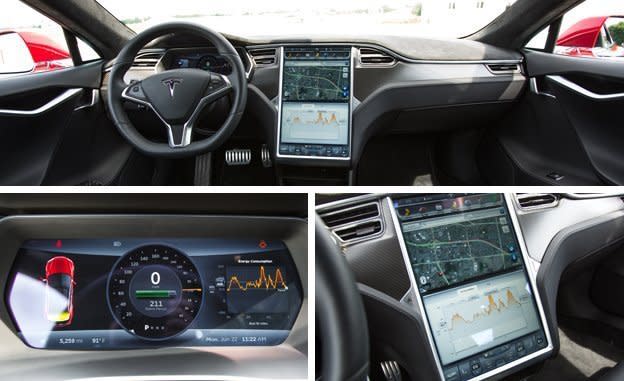
Even though our staff has driven Teslas on multiple occasions, the Model S experience still feels novel. It’s not just the smooth, silent acceleration or the act of plugging in every time you park that makes the Tesla so different. The Model S is full of idiosyncrasies, chief among them just how many switches and buttons have been condensed into the sprawling 17-inch touch screen. You tap or drag a finger to pop the door locks, slide the sunroof, and warm the heated seats, both front and rear. There is no driver involvement in powering the car on. You simply get in with the key in your pocket, press the brake pedal, shift into drive, and whir away to your destination—usually quite rapidly, as we’ve yet to tire of the Tesla’s full-zoot Insane Mode setting.
It’s less simple, though, when your destination is farther than the EPA-rated 253-mile range. Online editor Alex Stoklosa claims the longest trip to date, traveling 1600 miles round-trip between Ann Arbor, Michigan, and Alton, Virginia. Tesla’s trip-planning software led him circuitously through Washington, D.C. (rather than the more direct, southeasterly route from Detroit) in order to utilize Tesla’s free Superchargers, where he stopped to recharge at roughly 100-mile intervals. At one point, the car lost confidence that it would make it to the next charge point and ordered him to backtrack 20 miles to a Supercharger he had already passed. Stoklosa summed up the experience thusly: “The Tesla is a great road-trip car that requires too much forethought and waiting to be good at road-tripping.” That won’t slow us down much, though. There are bound to be several more long journeys on the way to 40,000 miles in our 2015 Tesla Model S P85D.
Months in Fleet: 2 months Current Mileage: 5262 miles
Average Fuel Economy: 72 MPGe Battery Capacity: 85 kWh Range (EPA est): 253 miles
Service: $0 Normal Wear: $0 Repair: $0
Damage and Destruction: $552
Specifications >
VEHICLE TYPE: front- and rear-motor, 4-wheel-drive, 7-passenger, 5-door hatchback
PRICE AS TESTED: $136,720 (base price: $105,670)
MOTOR TYPE: front: AC induction, 221 hp, 243 lb-ft; rear: AC induction, 470 hp, 443 lb-ft; combined power rating, 463 hp, 687 lb-ft; 85-kWh lithium-ion battery pack
TRANSMISSION: 1-speed direct drive
DIMENSIONS:
Wheelbase: 116.5 in
Length: 196.0 in
Width: 77.3 in Height: 56.5 in
Passenger volume: 115 cu ft
Cargo volume (C/D est): 3 cu ft
Curb weight: 5010 lb
PERFORMANCE: NEW
Zero to 60 mph: 3.3 sec
Zero to 100 mph: 8.6 sec
Zero to 130 mph: 16.8 sec
Zero to 150 mph: 29.4 sec
Rolling start, 5–60 mph: 4.1 sec
Top gear, 30–50 mph: 1.9 sec
Top gear, 50–70 mph: 2.9 sec
Standing ¼-mile: 11.8 sec @ 114 mph
Top speed (governor limited): 160 mph
Braking, 70–0 mph: 161 ft
Roadholding, 300-ft-dia skidpad: 0.89 g
FUEL ECONOMY:
EPA city/highway driving: 89/98 MPGe
C/D observed: 72 MPGe
WARRANTY:
4 years/50,000 miles bumper to bumper;
8 years/unlimited miles powertrain;
4 years/50,000 miles roadside assistance
WHAT WE LIKE: The novelty of driving a Tesla Model S P85D has settled into normalcy. After more than 10,000 miles, we’re no longer euphoric about the stealthy, snappy acceleration of 691 electric horsepower, nor are we as bemused by the prospect of one-pedal driving. In this case, though, familiarity hasn’t bred contempt. We remain impressed by the Model S’s performance, luxury, and real-world usability.
Life with a Model S is notably easier today compared with when we took delivery in April 2015. In September, our local power company dropped a new electrical line to our Ann Arbor office, providing enough power to charge our Model S at 240 volts and 80 amps. We can now add 58 miles of range per hour of charging, and if we’re truly in a rush, there’s a newly opened Supercharger less than three miles from our office. Bypassing the onboard charger with direct current at up to 400 volts pumps in electricity at a rate of hundreds of miles per hour. Tesla’s network of 227 (and counting) Supercharger locations in the United States now includes three in Michigan, with a fourth scheduled to come online in our home state by the end of 2015. While electricity still isn’t as convenient as gasoline, our charging times are shrinking and the area our Model S can reasonably reach is growing.
Our Model S has also grown smarter. The latest software, version 7.0, introduced new semiautonomous driving features like hands-free lane-keeping, automatic lane changing, and automated parallel parking. Tesla’s Autopilot isn’t flawless, but compared with the systems from Mercedes-Benz and BMW, it does a better job of staying centered in its lane, tracking around bends, and allowing the car to cruise for longer periods without driver input.
WHAT WE DON’T LIKE: Not only is Tesla prohibited from selling cars here, but Michigan law prevents Tesla from working on customers’ cars within the state at company-owned service centers or using its roving Ranger team. Our nearest service center is 180 miles away, just outside of Cleveland, Ohio, so repair work means the car is gone for days at a time.

Several drivers have opined that the Model S is at least one size too big to be practical. With a footprint larger than that of an Audi S8, it can be unwieldy on city streets and in parking garages. Solo commuters lament that a portion of the car’s electric range is squandered carrying around so much extra mass. “I’d prefer everything at nine-tenths: performance, size, price, and interior space,” noted technical director Don Sherman. In other words, Tesla’s smaller and cheaper Model 3 can’t get here soon enough.
And Tesla whiffed on stowage. Despite the spacious and airy interior, there isn’t a good place to stash small items. There are no door pockets, and the cup holders occupy the same space as the driver’s and passenger’s inboard elbows. The low, shallow pan between the front seats allows phones and sunglasses to slide around at every corner and stoplight and is difficult to reach. The single slot for small items just below the giant touch screen is good only for soft items. Every time you heartily tap into the Tesla’s forward thrust, anything in that cubby is launched into the cabin. Tesla sells an accessory center console with additional cup holders and a phone dock through its dealers, but who wants to pay $600 for something that should be standard on a $100,000 car?
WHAT WENT WRONG: We spent $552 to buy and install a new Michelin Pilot Sport PS2 after we sacrificed a tire to the Michigan road system just a month into our test. At 5500 miles, we suffered a cracked windshield, and Tesla shipped a replacement to our local installer. We spent $945 for the new glass and installation.
A few nagging issues convinced us to send our Tesla to Ohio for warranty work with 9400 miles on the odometer. The roof-rack flaps frequently flipped up at speed, and a clicking noise occasionally came from the passenger-side footwell area during moderate acceleration and braking. But the real impetus for the service visit was an irritating squeak caused by the driver’s seat rubbing against the center console.

Our car was retrieved by a Tesla agent and trailered to Cleveland, where technicians fixed the roof-rack covers and torqued the suspension bolts, although the shop couldn’t replicate the clicking that we reported. That seems to have done the trick, as the suspension is now as silent as the powertrain.
Tesla’s team was less successful with the driver’s seat. The technicians determined that our seat’s frame was bent and installed a new seat only to discover that that one had internal problems, as well. The shop ordered another but returned the car to us because it wasn’t due to arrive for several weeks. We’re still waiting to schedule a return visit to have the seat installed.
WHERE WE WENT: Aside from one 1600-mile road trip to Virginia, we’ve stayed relatively close to home with our Model S. Trips to the Lake Michigan shoreline and northern Michigan are now significantly easier thanks to the new Supercharger in Grand Rapids. We’ve also made multiple trips to Chicago and back by way of the Supercharger stations.
More important is the fact that the Model S can go home with any Car and Driver staffer on a given night. Thanks to its large battery pack, the Model S can easily cover a 100-mile round-trip commute on a single charge with range to spare for a trip to the grocery store or soccer practice. It’s the only electric car on the market with enough range to accommodate a typical workday.
Months in Fleet: 6 months Current Mileage: 12,324 miles
Average Fuel Economy: 73 MPGe Battery Capacity: 85 kWh Range (EPA est.): 253 miles
Service: $0 Normal Wear: $0 Repair: $0
Damage and Destruction: $1497
Specifications >
VEHICLE TYPE: front- and rear-motor, 4-wheel-drive, 7-passenger, 5-door hatchback
PRICE AS TESTED: $136,720 (base price: $105,670)
MOTOR TYPE: front: AC induction, 221 hp, 243 lb-ft; rear: AC induction, 470 hp, 443 lb-ft; combined power rating, 463 hp, 687 lb-ft; 85-kWh lithium-ion battery pack
TRANSMISSION: 1-speed direct drive
DIMENSIONS:
Wheelbase: 116.5 in
Length: 196.0 in
Width: 77.3 in Height: 56.5 in
Passenger volume: 115 cu ft
Cargo volume (C/D est): 3 cu ft
Curb weight: 5010 lb
PERFORMANCE: NEW
Zero to 60 mph: 3.3 sec
Zero to 100 mph: 8.6 sec
Zero to 130 mph: 16.8 sec
Zero to 150 mph: 29.4 sec
Rolling start, 5–60 mph: 4.1 sec
Top gear, 30–50 mph: 1.9 sec
Top gear, 50–70 mph: 2.9 sec
Standing ¼-mile: 11.8 sec @ 114 mph
Top speed (governor limited): 160 mph
Braking, 70–0 mph: 161 ft
Roadholding, 300-ft-dia skidpad: 0.89 g
FUEL ECONOMY:
EPA city/highway driving: 89/98 MPGe
C/D observed: 73 MPGe
WARRANTY:
4 years/50,000 miles bumper to bumper;
8 years/unlimited miles powertrain;
4 years/50,000 miles roadside assistance
WHAT WE LIKE: Riding in Car and Driver’s long-term Tesla Model S P85D may result in feeling butterflies in your stomach, or your stomach in your throat, or the sensation that partially digested butterflies might suddenly stream out of your throat. These are just a few of the reactions reported by passengers after thrill rides in Tesla’s electric rocket. Of all of the fast and slinky cars that pass through our parking lot, the Tesla Model S is the only one that consistently astounds automotive enthusiasts and agnostics in equal measure. We’re big fans of the P85D’s effortless 3.3-second zero-to-60-mph blast—sudden but never violent—but we’re even happier that Tesla seems to be getting average Americans excited about cars again.
Our drivers continue to be impressed with the car’s clever details, like the parking sensors that report the actual distance, in inches, to objects like fences, walls, and light posts rather than just blaring an alert and showing the driver an ambiguous red zone on a graphic display. Parents and kids alike enjoy the rear-facing third-row seats—kids for the novelty of the experience, and parents for the silence that comes after sequestering youngsters back there.

In January, a software update introduced Summon, a new feature that allows the driver to move the Model S into or out of a tight parking spot or garage while standing outside the car, either with no input whatsoever—touch a door handle to abort the self-parking mission—or by issuing commands via smartphone. While providing this foretaste of an autonomous-driving mode that would allow the owner to “summon” the car from a parking lot to, say, the curb in front of a restaurant, Tesla currently asks owners to restrict its use to private property. Here in the Midwest, where our parking lots are often even bigger than our cornfields, that restriction makes Summon more of a party trick than a useful function, but we’re still intrigued by an automaker that doesn’t stop improving a car after it’s been sold. However, Tesla’s tendency to leave these software functions in a seemingly perpetual Beta state also makes us wary that they’ll never be finalized.
WHAT WE DON’T LIKE: The limits of today’s battery technology immediately become clear whenever the temperature drops below 40 degrees. Winter posed a challenge for our Model S even though Michigan saw relatively mild temperatures and minimal snowfall. During one 20-degree weekend in late November, features editor Jeff Sabatini left the office on Friday with an indicated 225 miles of range, the maximum charge on the battery in its standard mode. He drove just 54 miles over the weekend and plugged in once to add 22 miles of indicated range, yet the car’s dashboard readout said he had just 59 miles remaining by Monday morning. That’s 134 miles of range lost to heating the cabin, conditioning the battery pack, and the efficiency reduction all EVs experience in the cold. This is a more extreme example, to be sure, and no doubt affected by the car spending most of the weekend outside and unplugged.
Still, it wasn’t uncommon to see 190 miles of range evaporate in a 130-mile round-trip drive to Detroit during the winter. This is, in large measure, why our observed fuel economy and range don’t approach the Tesla’s EPA ratings. Granted, our car is driven by various staff members, not all of whom have a garage, so it likely is exposed to cold weather a lot more than are most Snow Belt luxury cars. We’ve run plenty of conventional cars under the same conditions, though, without it routinely impeding their ability to perform the primary mission of getting from point A to point B. And the Model S’s cold-blooded sluggishness goes deeper. When the powertrain is cold, the deceleration capabilities and capture of energy from regenerative braking are either reduced or completely unavailable. (The Tesla also has a hydraulic braking system, so it still can, you know, stop.) The touchscreen becomes even less responsive than normal and it doesn’t work for drivers wearing gloves. And the frameless side windows rarely drop fast enough, so they often catch the weather stripping when the door is opened.
WHAT WENT WRONG: Just days before this update was written, a spring rainstorm resulted in water leaking into the cabin through the sunroof. While rain poured from the sky, it only dribbled into the cabin—just a few drops total—during hard left turns. At least the problem appeared at a convenient time. Our car was already scheduled to make the 182-mile trip to our nearest retailer in Lyndhurst, Ohio (near Cleveland), for its 25,000-mile service.

We’ve also asked the technicians to look at the 17-inch touchscreen, which responds reluctantly to our pokes and swipes, like a five-year-old iPhone that has undergone three operating-system updates. It’s especially annoying when using the satellite radio, as changing stations is met with lag that can be counted in whole seconds. Occasionally the radio also displays channel information for a station other than the one we’re listening to, and it often defaults to SiriusXM Hits 1 when we get into the car, subjecting our drivers to a kind of pop-music game of Russian roulette, with the chambers filled with the likes of Justin Bieber, One Direction, and Selena Gomez.
We should also point out that our P85D spec panels now show 463 horsepower for the combined output rather than the 691 horsepower that Tesla claimed when it initially released the car. While the P85D’s two electric motors are capable of producing 221 and 470 horsepower individually (for a total of 691), they can’t both make maximum power at the same time due to limitations of the power electronics and the battery pack. Tesla subsequently revised its claims but nothing changes on the car. Our long-term car is, and always has been, capable of mustering 463 horsepower (it was built before the $7500 option to get 532 horsepower in Ludicrous mode was available).
WHERE WE WENT: It took 11 months for our Model S to cross the halfway mark in this 40,000-mile test. That’s far longer than it typically takes to accumulate miles during our long-term tests, almost certainly because few of our drivers are willing to subject themselves—and their families—to the extra time required for a Tesla road trip. Since our 1600-mile road trip last May, its longest excursion has been to Louisville, Kentucky, a 350-mile journey that took seven clock hours in the Model S, instead of the usual five and a half burning gasoline.
Months in Fleet: 13 months Current Mileage: 23,958 miles
Average Fuel Economy: 67 MPGe Battery Capacity: 85 kWh C/D Observed Range: 180 miles
Service: $0 Normal Wear: $0 Repair: $0
Damage and Destruction: $1497
Specifications >
VEHICLE TYPE: front- and rear-motor, 4-wheel-drive, 7-passenger, 5-door hatchback
PRICE AS TESTED: $136,720 (base price: $105,670)
MOTOR TYPE: front: AC induction, 221 hp, 243 lb-ft; rear: AC induction, 470 hp, 443 lb-ft; combined power rating, 463 hp, 687 lb-ft; 85-kWh lithium-ion battery pack
TRANSMISSION: 1-speed direct drive
DIMENSIONS:
Wheelbase: 116.5 in
Length: 196.0 in
Width: 77.3 in Height: 56.5 in
Passenger volume: 115 cu ft
Cargo volume (C/D est): 3 cu ft
Curb weight: 5010 lb
PERFORMANCE: NEW
Zero to 60 mph: 3.3 sec
Zero to 100 mph: 8.6 sec
Zero to 130 mph: 16.8 sec
Zero to 150 mph: 29.4 sec
Rolling start, 5–60 mph: 4.1 sec
Top gear, 30–50 mph: 1.9 sec
Top gear, 50–70 mph: 2.9 sec
Standing ¼-mile: 11.8 sec @ 114 mph
Top speed (governor limited): 160 mph
Braking, 70–0 mph: 161 ft
Roadholding, 300-ft-dia skidpad: 0.89 g
FUEL ECONOMY:
EPA city/highway driving: 89/98 MPGe
C/D observed: 67 MPGe
C/D observed range: 206 miles
WARRANTY:
4 years/50,000 miles bumper to bumper;
8 years/unlimited miles powertrain;
4 years/50,000 miles roadside assistance

 Yahoo Autos
Yahoo Autos 